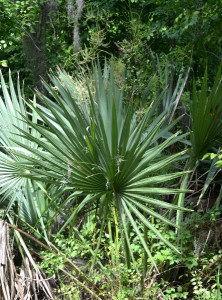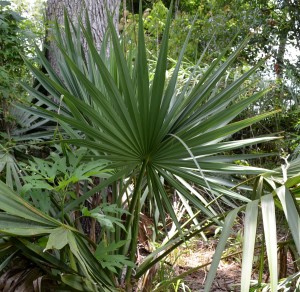Louisiana Dwarf Palmetto
Often overlooked as a landscaping choice when visiting your local nursery, the Dwarf Palmetto is a complex native palm of Louisiana that deserves a closer look. Able to grow in even the poorest soil conditions, this palmetto, Sabal minor, thrives in the heat and humidity and is even hardy enough to survive the chilly winters of southeastern Louisiana. A mere glance around wooded or marshy areas, especially where land meets water, will reveal a trove of lush palmettos, flourishing everywhere.
Once the palmetto establishes itself in the soil, the trunk grows underground, making it difficult to transplant the mature plants. The seeds are thankfully easy to obtain, though, growing on stalks from the center of the plants in late spring and summer. Striking in the wild, Dwarf Palmettos make a magnificent addition to manmade landscapes, as well.
The Dwarf Palmetto (found naturally around cypress and oak trees) can easily acclimate to such a landscape if placed around the base of its natural neighbors. The smooth, forest green leaves, which stand out against the grays and browns of the tree trunks, appear as though they were spray-painted, the color is so vivid. Additionally, the fan-shaped fronds, formed by the long, pointed leaves, add an extra layer of depth and texture to the landscape.
In the spring, long stalks, often up to ten feet tall, grow from the center of the plants, bearing small, cream-colored flowers. The flowers then give way to black fruits, about a half inch in diameter, with a single seed. In the wild, black bears and raccoons still depend on the wild seeds as a food source and, as a result, are dispensers of the seeds, insuring continued propagation.
Historically, the Dwarf Palmetto played an important role in the lives of Louisiana natives and French colonists. The Choctaw, Chitimacha, and Houma Indian tribes used the palmetto fronds as roof thatching for their huts, with European settlers often following suit. Starting at the edge of the roof, the fronds were placed in rows, one atop the other, moving up toward the peak of the roof. In so doing, the fronds formed a durable roof that worked well to shed rainwater. Occasionally, palmetto fronds would comprise the exterior walls in the same manner, layered from top to bottom, forming a rainproof wall covering as well as insulation.
Native American tribes were known for using the Dwarf Palm for medicine and food, too. The Houma sliced the roots and baked them like a type of bread. They also used the dried roots in a decoction for the treatment of high blood pressure and kidney and urinary problems. Not to be confused with the Dwarf Palmetto, Saw Palmetto extract is used today to combat prostate problems. Even though Saw Palmettos can be found in Louisiana, they are not as common as the Dwarf Palmetto and can be distinguished by the small sharp spines which form saw-like edges and give the saw palmetto its name.

The Louisiana natives developed other ways to utilize this versatile native plant, like in basket weaving, a tradition that continues today. Weavers cut the center stalk of the plant, called the “heart,” from the living plant and hang them upside down to dry. After several weeks, the dark green fades to a light color as the stalk dries out. Once completely dry, the stalk can then be separated into long, thin strips, which are soaked in water to make them pliable before being woven together to make hats and baskets.
The Houma continue the tradition of palmetto weaving in Louisiana, making hats, placemats, and baskets to sell at festivals and open marketplaces. The easiest and most common weave is the flat-braid weave used to make hats, placemats, and fans. The more intricate half-hitch weave is used to make beautiful, sturdy baskets, taking days to complete. Samples of the Houma crafts can be found at the National Museum of the American Indian in Washington, D.C. and at local museums in Lafayette, Houma, and Natchitoches.
Ubiquitous in the Louisiana landscape, the Dwarf Palmetto is often taken for granted and vilified as a common nuisance. Considering its usefulness, beauty, and availability, this robust palm should be appreciated not only as an element of a fertile landscape but as a viable part of our state history.
To see more samples of Houma crafts made with Dwarf Palmetto, visit louisianafolklife.org and search for “Houma basket weavers.”
(This piece originally appeared in Country Roads Magazine and is republished here by agreement.)
I hope you enjoyed learning about just one more useful indigenous plant down here in bayou country!
BW









I really did enjoy reading your article. The basket and other piece (what is that?) are very pretty. I love the natural color.
That palmetto would grow great in my swampy back yard!
The other thing is a “trivet” on which to place hot pots or dishes. Yes, they would. I’m surprised you don’t already have them!
Thanks for sharing. Very interesting.
You are most welcome! When you coming down?
Very interesting! The use of native plants in landscaping is an important in some parts of the country. It’s surprising that the palmetto isn’t used more in southern LA landscaping. The next time I visit your way I’d like to see (in museums) some more examples of the crafts made from palmettos.
I’m not sure of a museum where you might see these crafts. I can show you my miserable attempt at this basket, this actual basket, and the hot pad pictured above! I actually harvested the heart of palmetto, dried it, soaked it, stripped it and wove it myself, although I never honed my weaving skills to the point I could do it deftly and/or without looking!
Does your Mother-in-law or any of The Captian’s family weave? I think this would be a great therapy craft tool. They are just beautiful.
No, none of them do. Dotter and I took a class from a local Houma woman when Dotter was about 16. If I would’ve kept it up, I might be proficient by now, some 16 years later!!!!
Have you added something to your site? I am getting pop-ups on the top and across the bottom of my screen every time I open the page. I tried closing them and it won’t work.
Hm. The only thing different is a bright green bar at the top to sign up for email notifications for new folks. I will have to check into this and thanks for letting me know!
Cammy, the bar at the top is not a pop up. I put it there for new followers. There are some social media buttons that show up either on the side or at the bottom depending on what type of monitor settings you have, but neither of these things should interrupt your viewing experience! If you are getting some other type of “pop ups” I need to know what they are because we see absolutely nothing out of the ordinary on this end.
I am getting the bright green bar and I can close it but, it comes back up after a couple if minutes. The 5 media buttons are on the bottom and are fairly large on my screen (about an inch tall. Is there a way to make them smaller?
Cammy, this has to do with your Display Settings on your screen. You may have it set at 800 x 600 and most sites these days are designed for viewing on computer screen AND smart phones, and the best resolution for viewing on your computer is at least 1280 wide. The media buttons are sized “medium” right now, and if I make them smaller, they will be too tiny on most screens. Sorry for the inconvenience, but maybe try changing your screen resolution??? The green bar will stay there, as it has a feature for folks who view on smart phones and can click it to share my site via text, and it’s already producing new followers. So, again, I’m sorry you’re having troubles. I hope you don’t leave me because of it!!!
No way I would leave my favorite blog! I’ll see if I can reset.
I hope Palmetto Bug comes by to read this. In her part of South Carolina, this sort of basket-weaving is common, and a traditional craft. I’m not sure if they use palmetto or other kinds of sea grasses. I’ll have to check it out.
We have a Palmetto State Park here in Texas. It’s a fantastic place, filled with a great mix of natives in addition to the palmettos. A little farther down the coast, they seem to have been adopted for landscaping more than they have been here. They are beautiful. They always make me think of Cleopatra, being fanned by her servants way, WAY back in the day!
Great article! Thanks for posting it here, so we could enjoy it, too.
Sorry for any inconvenience these minor changes may have caused, although I can’t see why those things might be happening.
I hope she stops by, too. haven’t heard from her in a while. They make me think of the sevants fanning the lady of the house at the dining table in some old movie, too.
We were in Dallas today and passed one of the largest Goodwills I have ever seen. Had to get hubby to go back and while browsing, I found a handwoven, palmetto basket! It was exactly like the one in the photo above. I started to buy it but, unfortunately, someone had sat it in something that had stained the bottom really bad and it had began to soak thru to the inside. I don’t think it was very old because it wasn’t dried or brittle. A shame it had been stained so bad. It would have made a great sewing basket.
I think I might have bought it anyway and tried to bleach it. This size sells for about $75! How much was it?
Oh my goodness. It was 99 cents. I never thought of bleaching it. And it is too far to go back over there.
I just showed this to hubby and he said I told you to get it if you wanted it. Darn it!
Completely off subject. Just wanted to ask if any of your family in the Bossier/Shreveport area are affected by the Red River flooding?
Thankfully, no. Thank you for asking!
Do you know where the dwarf palmetto can be purchased. I have a fence I would love to plant them along.
I emailed you, Kenny! Thanks for stopping by. For others, the answer is if you are in south Louisiana, the bigger nurseries might carry them. You can find them in the wild and transplant, but I’d do some online research first to see how and the best time to do this! They don’t always “take”! Best of luck to you! BW
I’m having a hard time finding a dwarf palmetto palm tree. Would you know where to find one?
No sorry. I saw some in a Google search but they weren’t LA palmettos.
Where can I get true Louisiana palmetto seed or starts? I don’t want to trespass and dig one up. I only find Florida version online.
Hi Jessi and thanks for writing. I’m so sorry that I don’t know where you might obtain them. Dupont Nursery in Plaquemine is a wholesale nursery, but they have vast knowledge of La. plants. Maybe if you email them from their website, they can point you in the right direction. If you see one in the wild, why not go ahead and dig it up??? If you know the property owner, just ask. I’m sure they wouldn’t mind. Best of luck to you! BW